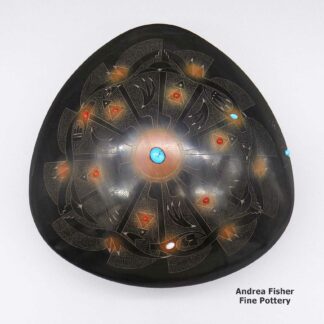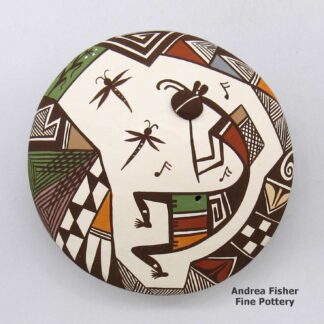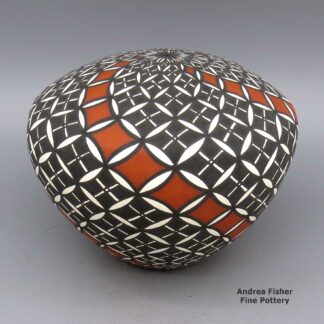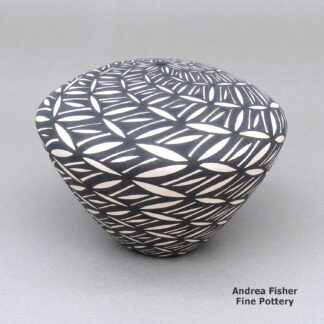Seed pot
About the Seed Pot
It was a matter of survival to the ancient Native American people that seeds be stored properly until the next planting season. Small, hollow pots were made to ensure that the precious seeds would be kept safe from moisture, light, bugs, reptiles and rodents.
After seeds were put into the pot, the small hole in the pot was plugged. The following spring the plug was removed and the seeds were shaken from the pot directly onto the planting area.
Today, seed pots are no longer necessary due to readily available seeds from commercial suppliers. However, seed pots continue to be made as beautiful, decorative works of art.
The sizes and shapes of seed pots have evolved and vary greatly, depending on the vision of Clay Mother as developed through the artist. The decorations vary, too, from undecorated white, buff or red seed pots to multi-colored painted, carved, applique and sgraffito designs, sometimes with inlaid gemstones, micaceous clay and silver or clay lids.
Because of the multitude of shapes and sizes, the name "seed pot" is generally reserved for pieces with tiny openings.
Showing 1–12 of 52 results
-

Alvina Yepa, zzje3c310, Seed pot with sgraffito design
$325.00 Add to cart -

Amanda Lucario, zzac3b132m1, Seed pot with a geometric design
$195.00 Add to cart -

Amanda Lucario, zzac3b132m2, Seed pot with a geometric design
$195.00 Add to cart -

Amanda Lucario, zzac3b132m3, Seed pot with a geometric design
$195.00 Add to cart -

Amanda Lucario, zzac3b133, Seed pot with a geometric design
$110.00 Add to cart -

Art Cody, aka Haungooah, lksc2l314: Polychrome seed pot
$1,550.00 Add to cart -

Barbara Gonzales, zzsi3b549, Seed pot with sienna spots and a sgraffito geometric design
$2,850.00 Add to cart -

Carolyn Concho, zzac2m084m8, Polychrome seed pot with applique and geometric design
$225.00 Add to cart -

Carrie Chino Charlie, paac2l305: Black-on-white seed pot with geometric design
$195.00 Add to cart -

Cletus Victorino, zzac2k047m3: Black-and-white jar with geometric design
$425.00 Add to cart -

Cletus Victorino, zzac2k050: Polychrome seed pot with geometric design
$795.00 Add to cart -

Cletus Victorino, zzac3a130m3, Black and white seed pot with geometric design
$275.00 Add to cart
Showing 1–12 of 52 results